-
 Bitcoin
Bitcoin $106,754.6083
1.33% -
 Ethereum
Ethereum $2,625.8249
3.80% -
 Tether USDt
Tether USDt $1.0001
-0.03% -
 XRP
XRP $2.1891
1.67% -
 BNB
BNB $654.5220
0.66% -
 Solana
Solana $156.9428
7.28% -
 USDC
USDC $0.9998
0.00% -
 Dogecoin
Dogecoin $0.1780
1.14% -
 TRON
TRON $0.2706
-0.16% -
 Cardano
Cardano $0.6470
2.77% -
 Hyperliquid
Hyperliquid $44.6467
10.24% -
 Sui
Sui $3.1128
3.86% -
 Bitcoin Cash
Bitcoin Cash $455.7646
3.00% -
 Chainlink
Chainlink $13.6858
4.08% -
 UNUS SED LEO
UNUS SED LEO $9.2682
0.21% -
 Avalanche
Avalanche $19.7433
3.79% -
 Stellar
Stellar $0.2616
1.64% -
 Toncoin
Toncoin $3.0222
2.19% -
 Shiba Inu
Shiba Inu $0.0...01220
1.49% -
 Hedera
Hedera $0.1580
2.75% -
 Litecoin
Litecoin $87.4964
2.29% -
 Polkadot
Polkadot $3.8958
3.05% -
 Ethena USDe
Ethena USDe $1.0000
-0.04% -
 Monero
Monero $317.2263
0.26% -
 Bitget Token
Bitget Token $4.5985
1.68% -
 Dai
Dai $0.9999
0.00% -
 Pepe
Pepe $0.0...01140
2.44% -
 Uniswap
Uniswap $7.6065
5.29% -
 Pi
Pi $0.6042
-2.00% -
 Aave
Aave $289.6343
6.02%
Should I stop loss when the volume suddenly decreases and pulls back in the upward trend?
A sudden drop in volume during an uptrend may signal weakening momentum, suggesting traders consider tightening stop-loss levels to manage risk effectively.
Jun 19, 2025 at 04:15 am
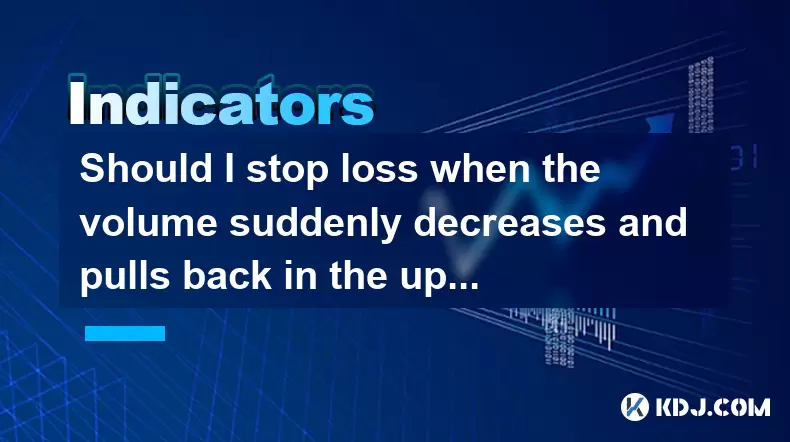
Understanding Volume and Price Action in Cryptocurrency Trading
In cryptocurrency trading, volume serves as a critical indicator of market sentiment. When volume suddenly decreases during an upward trend, it often signals a loss of momentum or interest from traders. This could lead to a pullback, which is a temporary reversal in price movement. Traders frequently ask whether they should place a stop-loss order under such conditions.
It’s essential to understand that volume reflects the strength behind a price move. A rising price accompanied by high volume suggests strong buying pressure, while a rising price with low volume may indicate weakness in the uptrend. If you notice a sudden drop in volume followed by a price pullback, this could be a warning sign that the trend might not be sustainable.
The Role of Stop-Loss Orders in Risk Management
A stop-loss order is a risk management tool used to limit losses on a trade. It automatically closes your position when the price reaches a specified level. In volatile markets like cryptocurrency, setting a stop-loss helps protect capital when the market moves against you.
However, placing a stop-loss based solely on volume contraction requires careful consideration. A sudden decrease in volume doesn’t always mean a reversal is imminent. Sometimes, consolidation occurs before a continuation of the trend. Therefore, relying only on volume without analyzing other technical indicators can result in premature exits from potentially profitable trades.
Analyzing Pullbacks Within Uptrends
A pullback refers to a short-term decline in price within a larger uptrend. These are common in both traditional and crypto markets. The key question for traders is whether the pullback is a healthy correction or the beginning of a reversal.
When you observe a volume drop alongside a pullback, consider the broader context:
- Is the price still above key moving averages?
- Are support levels holding?
- Is there any negative news affecting the asset?
If the answer to these questions leans toward a continuation rather than a reversal, then adjusting your stop-loss tighter instead of exiting completely might be more strategic. Placing a stop below a recent swing low can help protect against downside risk without being prematurely stopped out.
Combining Volume Analysis With Other Technical Indicators
Relying solely on volume and price action may not provide a complete picture. Integrating additional tools like moving averages, RSI (Relative Strength Index), or MACD (Moving Average Convergence Divergence) can improve decision-making accuracy.
For example:
- If RSI remains above 50, it suggests that the uptrend is still intact.
- If MACD lines cross bullish again, it reinforces the idea that the pullback may be ending.
- If volume rebounds, it confirms renewed interest in the asset.
Using these tools together allows you to make informed decisions about whether to adjust or maintain your stop-loss settings.
Practical Steps to Adjust Stop-Loss Based on Volume Drops
Here’s how you can approach adjusting your stop-loss when you see a sudden volume drop and pullback:
- Identify key support levels: Use previous lows or Fibonacci retracement levels to determine logical stop-loss placement.
- Monitor volume trends: Compare current volume to average volume over the past few sessions to detect anomalies.
- Assess candlestick patterns: Look for signs of rejection at support or resistance levels.
- Use trailing stops: Instead of fixed stop-loss points, consider using a trailing stop that adjusts as the price moves in your favor.
- Avoid emotional reactions: Don’t panic-sell just because volume dips temporarily.
By following these steps, you can better manage your positions and avoid unnecessary losses caused by misinterpreting volume fluctuations.
Frequently Asked Questions
Q: What does a sudden drop in volume typically indicate in crypto trading?
A sudden drop in volume usually signals reduced interest or indecision among traders. While it doesn’t guarantee a reversal, it may suggest that the current trend is losing steam and could pause or correct.
Q: Can I rely solely on volume to decide when to place a stop-loss?
No, volume alone isn't enough. It should be combined with price action, trendlines, and other technical indicators to form a comprehensive trading strategy.
Q: How do I differentiate between a pullback and a trend reversal?
Focus on key support/resistance levels, trendline integrity, and confirmation from indicators like RSI or MACD. A true reversal will often break major trendlines and show sustained weakness.
Q: Should I move my stop-loss tighter during a pullback?
Yes, tightening your stop-loss during a pullback can protect profits and reduce risk. However, ensure your stop is placed logically, considering recent price swings and volatility.
Disclaimer:info@kdj.com
The information provided is not trading advice. kdj.com does not assume any responsibility for any investments made based on the information provided in this article. Cryptocurrencies are highly volatile and it is highly recommended that you invest with caution after thorough research!
If you believe that the content used on this website infringes your copyright, please contact us immediately (info@kdj.com) and we will delete it promptly.
- Filecoin, Secure Storage, and Avalanche Enterprises: A New Era of Blockchain Collaboration
- 2025-06-20 14:45:13
- SEI Price Surge: Decoding the Reasons Behind the Rise
- 2025-06-20 14:25:12
- Cryptos for the Long Haul: Early Investors' Edge in 2025
- 2025-06-20 14:25:12
- Bitcoin Price in June 2025: Riding the $100K Wave?
- 2025-06-20 14:45:13
- Tether, Stablecoins, and Public Offerings: A New York Perspective
- 2025-06-20 15:05:13
- XRP Price Consolidates as Solana Meme Coin Snorter Token Gains Traction
- 2025-06-20 15:25:12
Related knowledge
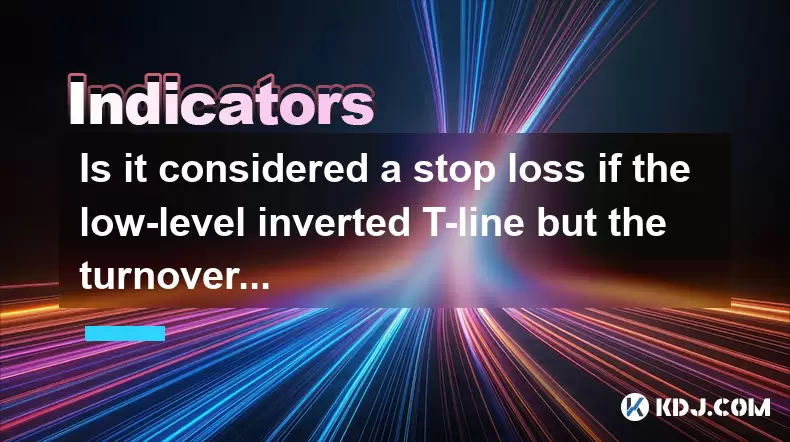
Is it considered a stop loss if the low-level inverted T-line but the turnover rate is extremely low?
Jun 20,2025 at 04:49pm
Understanding the Low-Level Inverted T-Line in Cryptocurrency ChartsIn technical analysis within the cryptocurrency market, candlestick patterns are crucial indicators for traders to predict potential price movements. The low-level inverted T-line is a specific type of candlestick pattern that often raises questions among traders. This pattern typically...

Is it a real drop when KDJ crosses but the trading volume shrinks?
Jun 20,2025 at 03:49pm
Understanding KDJ and Its Role in Cryptocurrency TradingIn the realm of cryptocurrency trading, technical analysis plays a crucial role in identifying potential price movements. The KDJ indicator, also known as the stochastic oscillator with a J line added for momentum confirmation, is widely used by traders to gauge overbought or oversold conditions. I...
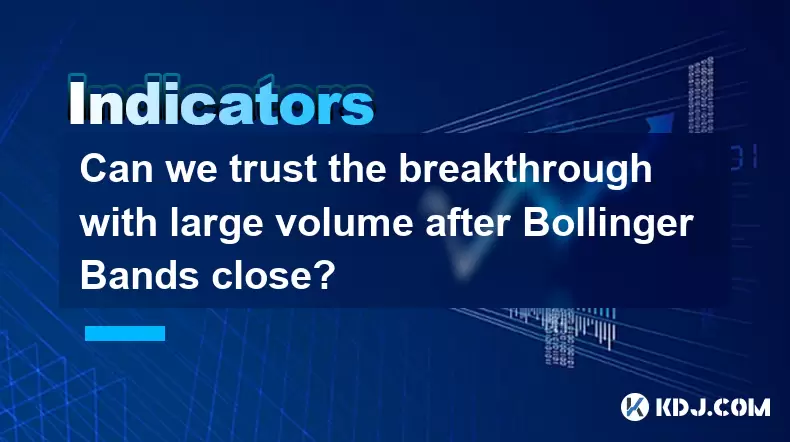
Can we trust the breakthrough with large volume after Bollinger Bands close?
Jun 20,2025 at 04:42pm
Understanding the Bollinger Bands MechanismBollinger Bands are a widely used technical analysis tool in cryptocurrency trading. They consist of a moving average, typically a 20-period simple moving average, and two standard deviation bands above and below it. These bands expand and contract based on market volatility. When the bands contract, they signa...
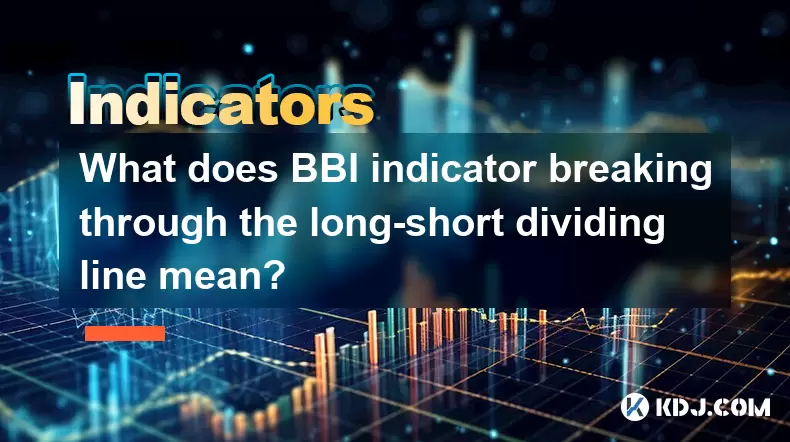
What does BBI indicator breaking through the long-short dividing line mean?
Jun 20,2025 at 04:28pm
Understanding the BBI IndicatorThe BBI (Bull and Bear Index) is a technical analysis tool used in cryptocurrency trading to identify market trends by combining multiple moving averages. Unlike traditional moving averages, which focus on a single time frame, the BBI incorporates several moving averages—typically short-term, medium-term, and long-term cyc...
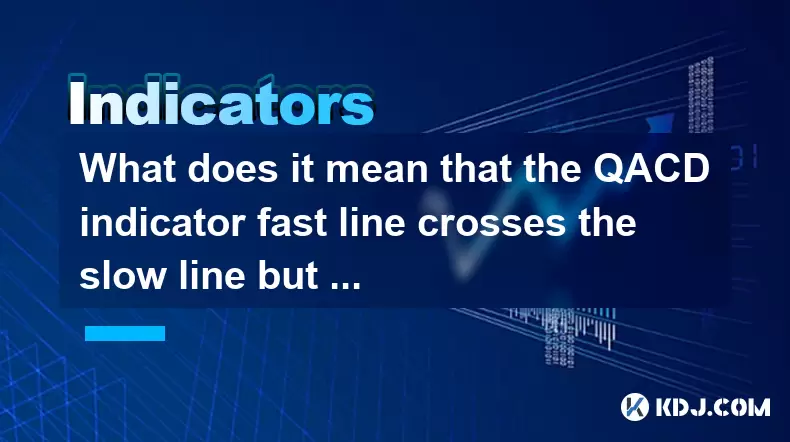
What does it mean that the QACD indicator fast line crosses the slow line but does not increase in volume?
Jun 20,2025 at 12:22pm
Understanding the QACD Indicator and Its ComponentsThe QACD (Quantitative Accumulation Convergence Divergence) indicator is a technical analysis tool used by traders to identify potential trend reversals, momentum shifts, and entry or exit points in cryptocurrency markets. It consists of two primary lines: the fast line, which reacts more quickly to pri...
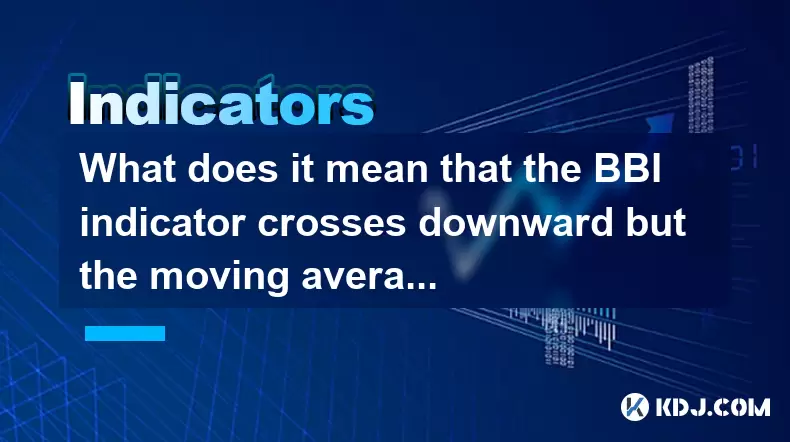
What does it mean that the BBI indicator crosses downward but the moving average does not cross?
Jun 20,2025 at 03:07pm
Understanding the Role of Blockchain in Cryptocurrency TransactionsBlockchain technology is the foundational infrastructure behind most cryptocurrencies. It serves as a decentralized, distributed ledger that records all transactions across a network of computers. This ensures transparency and eliminates the need for a central authority like a bank. Each...

Is it considered a stop loss if the low-level inverted T-line but the turnover rate is extremely low?
Jun 20,2025 at 04:49pm
Understanding the Low-Level Inverted T-Line in Cryptocurrency ChartsIn technical analysis within the cryptocurrency market, candlestick patterns are crucial indicators for traders to predict potential price movements. The low-level inverted T-line is a specific type of candlestick pattern that often raises questions among traders. This pattern typically...

Is it a real drop when KDJ crosses but the trading volume shrinks?
Jun 20,2025 at 03:49pm
Understanding KDJ and Its Role in Cryptocurrency TradingIn the realm of cryptocurrency trading, technical analysis plays a crucial role in identifying potential price movements. The KDJ indicator, also known as the stochastic oscillator with a J line added for momentum confirmation, is widely used by traders to gauge overbought or oversold conditions. I...

Can we trust the breakthrough with large volume after Bollinger Bands close?
Jun 20,2025 at 04:42pm
Understanding the Bollinger Bands MechanismBollinger Bands are a widely used technical analysis tool in cryptocurrency trading. They consist of a moving average, typically a 20-period simple moving average, and two standard deviation bands above and below it. These bands expand and contract based on market volatility. When the bands contract, they signa...

What does BBI indicator breaking through the long-short dividing line mean?
Jun 20,2025 at 04:28pm
Understanding the BBI IndicatorThe BBI (Bull and Bear Index) is a technical analysis tool used in cryptocurrency trading to identify market trends by combining multiple moving averages. Unlike traditional moving averages, which focus on a single time frame, the BBI incorporates several moving averages—typically short-term, medium-term, and long-term cyc...

What does it mean that the QACD indicator fast line crosses the slow line but does not increase in volume?
Jun 20,2025 at 12:22pm
Understanding the QACD Indicator and Its ComponentsThe QACD (Quantitative Accumulation Convergence Divergence) indicator is a technical analysis tool used by traders to identify potential trend reversals, momentum shifts, and entry or exit points in cryptocurrency markets. It consists of two primary lines: the fast line, which reacts more quickly to pri...

What does it mean that the BBI indicator crosses downward but the moving average does not cross?
Jun 20,2025 at 03:07pm
Understanding the Role of Blockchain in Cryptocurrency TransactionsBlockchain technology is the foundational infrastructure behind most cryptocurrencies. It serves as a decentralized, distributed ledger that records all transactions across a network of computers. This ensures transparency and eliminates the need for a central authority like a bank. Each...
See all articles

























































































